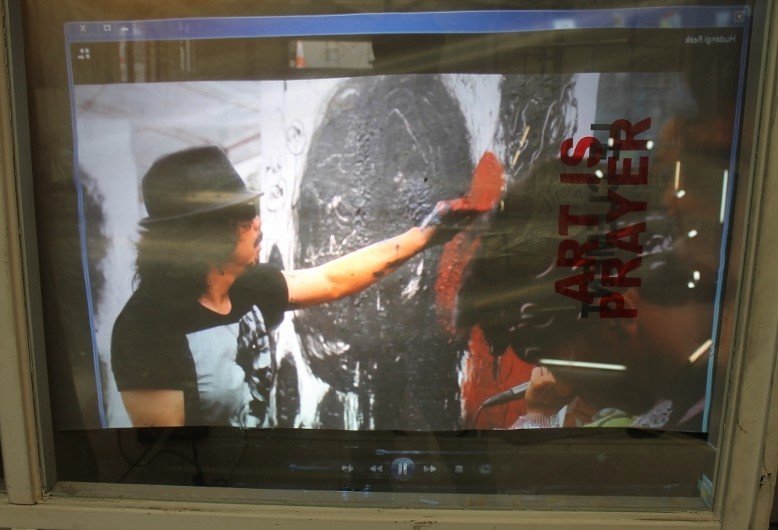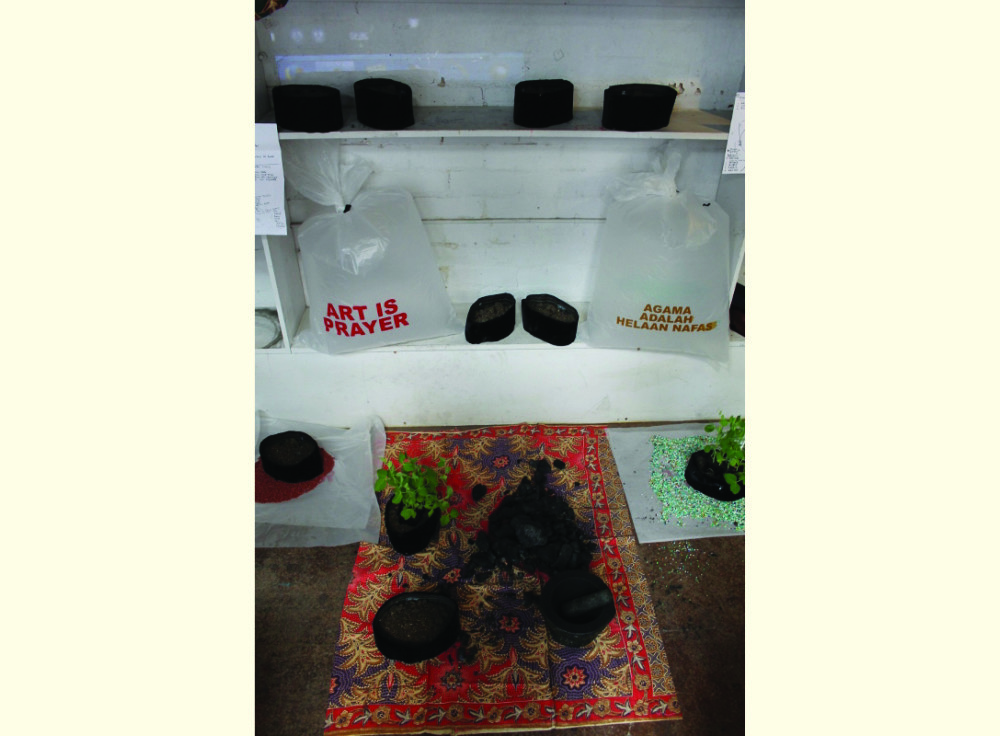
A video of Tisna Sanjaya in the act of “ngajeprut“, featured at Shout! Photo by Edwin Jurriens.
Considering the recent commercial boom in art from places like Indonesia and China, what does it mean to be “independent” in Asia today? While the commercial market is having a growing impact on artistic themes, media and working methods, a select group of artists have retained their creative independence, sincerity and consistency. One of the best examples is Bandung-based artist Tisna Sanjaya.
Sanjaya’s work is showing at the Shout! exhibition at the Meat Market in North Melbourne, alongside pieces from 14 other Indonesian contemporary artists, as part of Multicultural Arts Victoria’s annual Mapping Melbourne festival.
A sign of his creative versatility, in Melbourne Sanjaya is presenting a performance, an installation, and a framed, two-dimensional multimedia work. Both Sanjaya and others have referred to his work using the term jeprut. In Sundanese, a language spoken by about 40 million people predominantly in West Java, jeprut is an onomatopoeia that imitates the sound of something breaking. It can refer to the snapping of the string of a kite or the burning of wires in a short circuit. Both physically and spiritually, it embodies something breaking because of an imbalance in energies. It interrupts the normal state of affairs, and can create unforeseen opportunities, by releasing the particles of a whole in new and unexpected directions.
In one of his works in the Shout! exhibition, Palasari (2008), Sanjaya uses the remains of books from a shop in a traditional market area in Bandung, which had been repeatedly burnt down to make way for a modern shopping mall. He described a need to resurrect the books and their embodied creativity, civilisation and cultural memory from the ashes, and save them from any further negligence or abuse by the Indonesian state and society. Although the work is two-dimensional, it has multilayered and performative aspects. It contains the imprint of Sanjaya himself, as he used his own body to attach the ashes and various natural materials to the canvas. This connection between the artist, the burnt books and nature is reflected in Sanjaya’s description of the piece as “an offering and a sense of solidarity towards thinking, goodness, beauty of nature and humanity which are currently excluded by violent attitudes”.
As a creative manifestation of jeprut, Sanjaya’s work represents an outcry against socio-political and natural imbalances in the artist’s environment, an intervention in daily life, and the opening up of alternative pathways. What is moving and striking about Sanjaya’s art is its sense of urgency and honesty: in each of his works, there is a strong sense that the artist had no other choice than to express a certain issue at a certain time using certain media and styles. During the artists’ talks in Melbourne, Sanjaya explained that not following his conscience and intuition would make him feel “unclean”, physically scratching his body with his hands as if it was filthy and itchy. This uncleanliness, he said, would be directly felt and visible in any work of art.
According to a fellow artist, Sanjaya’s wife was the first to use the term jeprut to describe one of his performances, commenting “Tah si akang tos ngajeprut deui bae” (“Look, my husband is behaving erratically again”). This comment played on one of the connotations of jeprut and its related verb ngajeprut as “(behaving like a) mentally ill person”. Typically wearing dark clothes, headgear, sunglasses and/or make-up, and making ceremonial movements with his body, Sanjaya seems to enter a trance-like state that releases pressure, interrupts daily life and sets him apart from normal society. At the same time, the jeprut performance can also designate the artist as a genius and even have religious overtones. Illustrative of the syncretic character of religious belief in many parts of Java, Sanjaya’s performance rituals include elements of Islam, Hinduism, as well as animism.

One of the other works showing at the Shout! exhibition, Art is Prayer, suggests a connection between art, Islam and the natural environment. Photo by Edwin Jurriens.
Tellingly, one of Sanjaya’s other works in the Shout! exhibition is titled Art is Prayer. This installation consists of a small room with, among other items, Muslim prayer rugs and hats covered with charcoal, soil and plants, plastic bags covered in slogans and filled with air, and a short video of one of Sanjaya’s interactive public painting performances. The work suggests an organic connection between art, Islam and the natural environment. While the message of this installation is universal, it also embodies the spirit of Sanjaya’s art community in Cigondewah, South Bandung, an area known for cheap textile manufacturing. Sanjaya explained that some of the key problems of Indonesia’s industrialisation and democratisation are visible in this area: garbage, pollution, poverty, religious radicalisation and violence. He tries to use his art and the Cigondewah Cultural Centre, he said, to address these issues and provide alternatives.
The practice of jeprut is not limited to Sanjaya. Bandung-based protest artists and groups have been involved in various manifestations of jeprut since the 1980s. In December 2014, Sanjaya and some of the other pioneering jeprut artists, including Isa Perkasa, Marintan Sirait, Rahmat Jabaril, Herry Dim and Ine Arini, showed an impressive exhibition at Soemardja Gallery at the Bandung Institute of Technology (ITB). While looking back at the past, these artists try to keep alive the spirit of jeprut amidst the changing and challenging circumstances of Indonesia’s present and future. Both Sanjaya and Soemardja Gallery director and chief curator Aminudin TH Siregar expressed a desire to show work of the broader jeprut movement at the next Mapping Melbourne. These artists not only tell us stories about Bandung, but also help us to rethink the urban landscape of Melbourne in spiritual, critical and innovative ways.
The Shout! exhibition, featuring 15 Indonesian contemporary artists, is taking place at the Meat Market art space in North Melbourne until 22 December.




